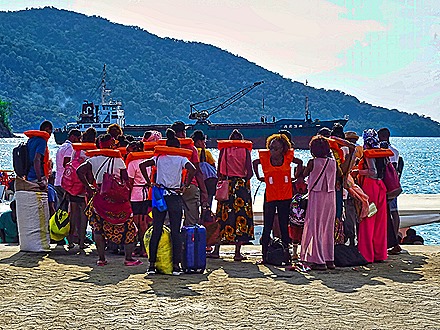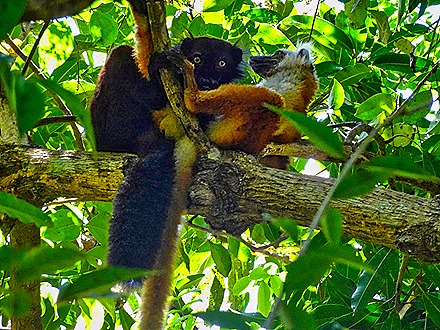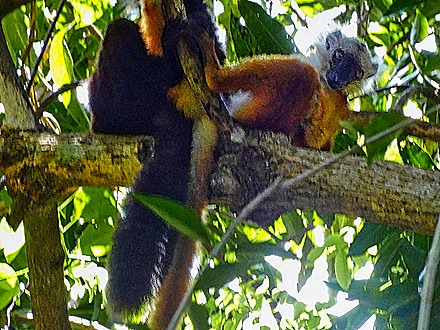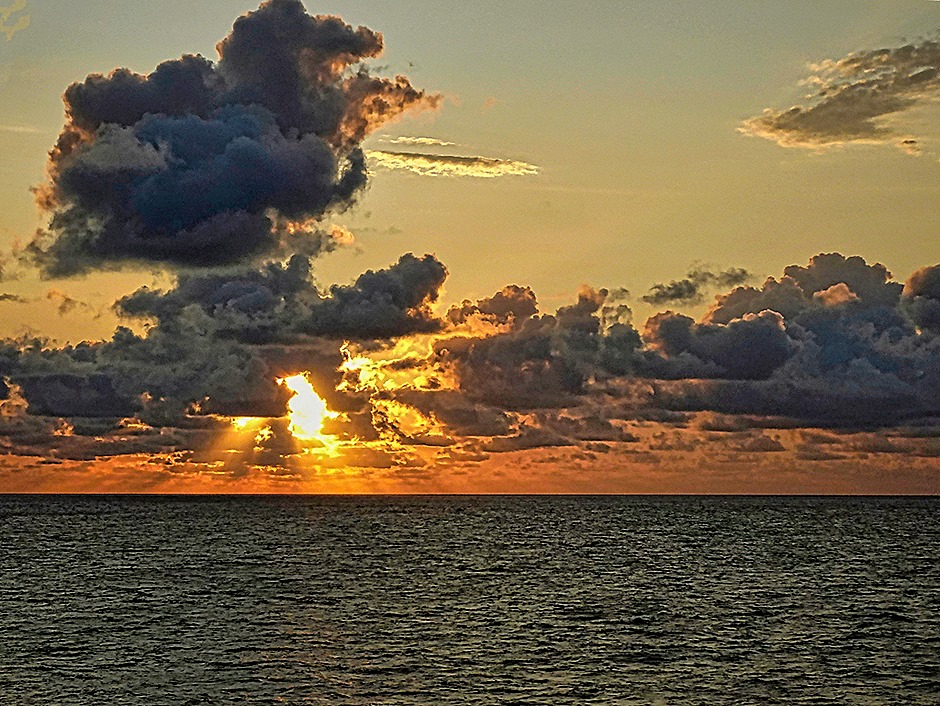Andoany, Nosy Be, Madagascar (Day 2) 2022
Because Madagascar has been an isolated island ecosystem for many millions of years its plants and animals have evolved independently from those you find everywhere else. In fact about 90% of the animal and plant species here are endemic to Madagascar and found naturally nowhere else in the world. The most famous of these is the Lemur. So on the morning of November 16 we tendered back in to the dock at Nosy Be to meet up with our excursion to Lokobe National Park for the Lemur part of our visit to Madagascar.
The dock area was very busy, not only with Zaandam passengers but with locals catching a boat to take them to their work places. We had to wait a very long time before our speedboat was ready for us to board for the trip to Lokobe, the primary home of wild lemurs in this area (you can see some in semi-captivity elsewhere but we wanted to visit them in their natural homes).
After a lengthy boat ride we came ashore on a beach. It was a “wet landing,” which means you step out of the boat into the water and wade ashore. There is what appears to be a small village on the edge of the forest by the beach, which we think may be called Ampasipohy. There were boats around so it is likely a fishing village, probably with some agriculture, but it is certainly used to receiving travelers. When we arrived folks were busily setting out their products for sale. We saw no evidence that these clothes, embroidered table cloths and souvenirs were being produced in the village, so were they made in Madagascar or somewhere else, like China? It was hard to tell.
The point of this trip was to walk through the very tall and dense forest to see lemurs and other fauna. We were led by a couple of guides who knew the area very well and were able to spot lemurs high in the tree branches. As we had found on our African safari in 2018, even when they pointed the animals out to us it was often difficult for us to see them.
There are more than 100 species of lemur in Madagascar. There once were some as big as gorillas but they, along with about 15 other species, have become extinct since these islands were populated by humans. Most of the lemur species are now endangered, primarily because of rapidly shrinking habitat, but lemurs are also hunted for food by some. Lokobe has been a protected refuge for these interesting critters since 1927 and it became a national park in 2014.
The lemurs we saw here are called Black Lemurs, something of a misnomer because only the males are black. The females are mostly brown to yellow in color with white around their faces. This forest is populated by very tall trees, some 100 feet tall and hundreds of years old. The lemurs were high in the branches and difficult to see from the ground, particularly when hiding behind leaves. We passed a baby lemur hanging onto a tree trunk in heavy shadow. Lemurs have a very intense countenance, with bright unblinking eyes that we understand are caused by reflective tissue in the back of their eyes.
Lemurs are not the only interesting animals in this park. Almost half of the 200+ species of chameleons in the world are endemic to Madagascar. We saw two species of chameleon. One was relatively large, facing down on a tree trunk. He (or she) was so well camouflaged that even after it was pointed out by others Rick had trouble seeing it until moving to the side (possibly a gecko, but we think it was a chameleon). The others were very tiny, about the size of a thumbnail. One of our guides showed them to us on a leaf. A new species of chameleon was just discovered in 2021 called Brookesia Nana, which is the smallest reptile in the world. But it may also have been Brookesia minima, which is the third smallest reptile in the world and is common in these parts.
We also saw a very tiny but brightly colored frog that one of out guides found and showed us, again on a leaf. We think this was an Orange Backed Mantella, also endemic to northern Madagascar, because of its coloring (scientific name Mantella ebenaui ). The bright coloring apparently deters predators wary of eating poisonous frogs (which these may actually be). It appeared that the only reason it didn’t hop away was the guide’s thumb on one of its back feet.
We encountered a boa constrictor, about 5 feet long, entwined on some branches in a tree. Since it was in a tree we think this must be a Madagascar Tree Boa. They live in the trees during the day but hunt on the ground at night.
Finally, there was a tiny gecko (we think), almost invisible among the brown leaves on the path. We might have stepped on it if the guide hadn’t pointed it out in time.
It was a pretty long hike back to the village over tricky terrain and the group got rather strung out. I was near the end and looking up (dangerous when walking because of the roots over the path) when I saw a couple of lemurs high in a tree. I felt pretty good about spotting them all by myself with no guides around. As before they mostly looked like shadows and I couldn’t tell what they were doing, but I took several pictures of them anyway since you never know what you will see when you enlarge and brighten them on the computer.
I was pretty surprised when I saw them on the computer. It was a male (black) and female (mostly brown) lemur and it looked like they were engaged in a passionate activity. As Cole Porter might say, “Birds do it, bees do it, even lemurs high in trees do it . . . . “ You will see what I mean when you get to the pictures. Alas, I later discovered using Google that the mating season for lemurs is in the Spring, and each female’s fertile period only lasts a couple of days. We were there in November so that couldn’t have been what they were doing. Probably grooming each other, although the female sure looked like she was enjoying it, at least until she noticed me watching.
As we neared the village we passed many vendors, mostly of embroidered table cloths, and what looked like a farm. We had to wait in the village for more than an hour for our lunch to be prepared because it apparently wasn’t started until we got back. What, didn’t they think we would make it back? The buffet of local food was eventually set out and was pretty good. Some of the guides and villagers sang for us, including their national anthem, in the thatched lunch hut.
After all this we walked down the long beach to the speed boats that would take us back to the tender dock. The tide seemed to have come in somewhat since there was a deeper wet embarkation than in the morning. The beach was quite beautiful. It was a long trip back to the dock and unfortunately we were sitting in the front part of the boat. The boat pilots (there were several boats) seemed to be racing each other and as the boat climbed a wave we were thrown out of our seats about 5 inches and when the boat went back down we hit the seats again, hard. Of course, the pilot in the back of the boat didn’t feel any of this. When you are piloting a speed boat full of older passengers more care should be taken; we had to hold on tight just to stay in our seats. It was a beautiful trip, but by the end of that ride our bodies felt pretty much broken and it took several days to recover. We hope Holland America makes sure that doesn’t happen again on future visits.
So that was it for our visit to Madagascar. We sailed away toward the southern part of the African continent past a very nice Indian Ocean sunset.


































Leave a comment